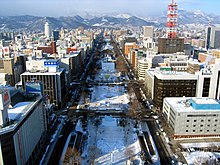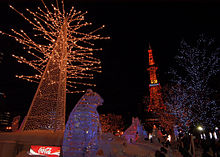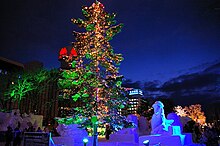Sapporo Snow Festival
The Sapporo Snow Festival ( Jap. さっぽろ雪まつり , Sapporo Yuki Matsuri ; Engl. Sapporo Snow Festival ) is one in the Japanese city of Sapporo conducted event . It is dominated by the production of winter sculptures mostly from snow or ice. Artists from all over the world come to the capital of the prefecture Hokkaidō for a week and create ephemeral works of art in prepared public spaces under "the eyes" of interested people. The festival was established as an Olympic event on the occasion of the 1972 Winter Olympics . The festival has its origins in 1949.
history
The first venue was the Ōdōri Park in the center of Sapporo, which extends between rows of houses over a length of 1.5 km (Ōdōri means "long street"). Japanese schoolchildren and students erected six larger sculptures made of snow at this point for the first time in 1949 . At the same time, snowball fights and cheerful carnival meetings took place on both days. Around 50,000 people attended the first snow festival. The stories of the participants and visitors to the park ensured that the festival soon became known nationwide and attracted more and more visitors and participants. In 1953, a 15-meter-high artfully executed snow sculpture Ascension (English for 昇天 shōten , German “Ascension” ) aroused the interest of all visitors. This in turn led to real competitions being held from the following year as to who would create the tallest or most beautiful figure. In 1955, for example, the Japanese Self-Defense Forces also took part, seeing their participation as an exercise. Since then, the soldiers have been taking part in the preparatory work on a regular basis: they help to transport the tons of snow into the village. On the occasion of the tenth anniversary of the snow festival in 1959, 2,500 artists have already registered to compete against each other. From this year radio and television broadcasters reported on the festival for the first time, after which the flow of visitors increased steadily. Tourists from the main island of Honshu , but also from other parts of the country and abroad, carried the festival experience “into the world”.
In 1965, the organizers opened a second, larger event area, Makomanai Park . A first international competition for the most beautiful sculpture has now been organized.
The Sapporo Snow Festival finally established itself in winter sports events when it was included in the supporting program of the Winter Olympics in 1972 under the category of art. After 1974, snow festivals also took place at the same time in Sapporo's twin cities such as Munich or Shenyang , and so the event expanded into an important international event.
To be able to offer even more space for all visitors and participants, the organizers added a third venue in 1983, Susukino, the red light district of Sapporo. Since then, the sculptures have also been illuminated in color, music plays (daily until 10 p.m.) and the duration of the festival has been extended to a full week. In addition to the snow art work, popular festivals with hype, snacks and small winter sports events for everyone developed.
The first venue, Ōdōri-Park, had to be closed at short notice in 2005, and Sapporo Satoland took its place . The Tsu Dome was added as a further venue in 2009 - currently (in autumn 2019) the three locations Ōdōri Park, Susukino and Tsu Dome are again planned for the festival. Every year around two million visitors come to the Sapporo Snow Festival and the organizers see no end to this development. Susukino is considered to be the location of the ice sculptures .
To cope with the flow of tourists to the event, the neighboring New Chitose Airport was expanded and JR Hokkaido is offering a rapid airport train from there to the center of Sapporo.
The 71st Sapporo Snow Festival ("International Snow Sculpture Contest") will take place from April 4th to 11th. February 2020 just prepared (as of November 2019). The organizers in turn announce the participation of teams or individuals from all over the world.
Similar winter cultural events are held in several places in other countries: the Harbin International Ice and Snow Festival or the Québec Carnival (since 1896). The Saint Paul Winter Carnival in the USA , which was first recorded in 1886, is considered to be the world's oldest snow sculpture event .
description
In the early years, the participating artists used the natural snow that was available in Sapporo. During the gradual expansion of the event, snow also had to be brought in from higher elevations on trucks . In order to get a compact “building material”, the tipped snow was also stuck on site by the truck. In this way, snow plates could then be cut off and ensured better handling and stability of the works of art. Sometimes these were also given a solid core made of metal or plastic.
With the rapid expansion of the event and the development of snow cannons , the participants soon had access to artificially produced snow. This could be adapted to the intended use and the longer shelf life by means of suitable chemical additives. In the meantime, almost all sculptures are made from a single block of snow, which weighs on average 20 to 30 tons and whose side lengths are between 1.80 and 4.5 m . The artists work on this with axes, saws or shovels according to their templates and carefully remove the material. Work stops at night.
There are no given topics, the design is completely up to the participants. Often, historical or current buildings typical of the country are executed as true to the original as possible, technical devices are "recreated", objects are formed from nature, people are represented or fantasy sculptures are created. In February 2019 there were around a dozen large ice palaces and works of art, as well as hundreds of smaller works by various groups. All previous sculptures are shown on the archive page of the Snow Committee: The available space for the buildings will be raffled among the applicants. Three first prizes will be awarded, although the selection of the winning works of art is not entirely clear.
Web links
- Official website of the Sapporo Snow Festival (English)
- Snow Festival Poster Archive
- John Daub: Sapporo Snow Festival Experience (2006) on youtube.com; Duration 12:11 minutes.
- Short video about the sculptures of the year 2019 , duration around 1:30 minutes.
- Sapporo ice palaces in Japan: Winter magic at the Sapporo Snow Festival on blickgewinkelt.de.
- The Sapporo Snow Festival 2019 on asienspiegel.ch.
References and comments
- ↑ Comment : Under "History" the year 1950 is the beginning and other sources regularly spread this. But in the rest of the history it says 1959: "the 10th anniversary". Therefore the beginning year has been adjusted in this lemma. In the following counts, too, the year 1949 is always calculated, as you can easily see for yourself (e.g. 2020 = 71st festival).
- ↑ domestic webpage on the history of the snow festival (in Japanese), retrieved November 19, 2019.
- ↑ Lars Nikolaysen: A lot of feeling for a lot of snow. Spiegel online, February 7, 2017, accessed on November 21, 2019 .
- ↑ a b c d e History of the Snow Festival. Retrieved November 17, 2011 .
- ^ Sapporo Snow Festival. www.japan.guide, 2019, accessed November 18, 2019 .
- ↑ a b Sapporo Snow festival 2020. Retrieved November 18, 2019 .
- ↑ Access. Retrieved November 18, 2019 .
- ↑ International Snow Sculpture Contest. Accessed November 17, 2019 .
- ↑ Quebec Winter Carnival. Retrieved November 18, 2019 .
- ^ Snow Sculpture. Wikipedia (English) < Where was the first international snow sculpture competition held? >, accessed November 18, 2019 .
- ^ Archive (About Contest). Retrieved November 17, 2019 .




